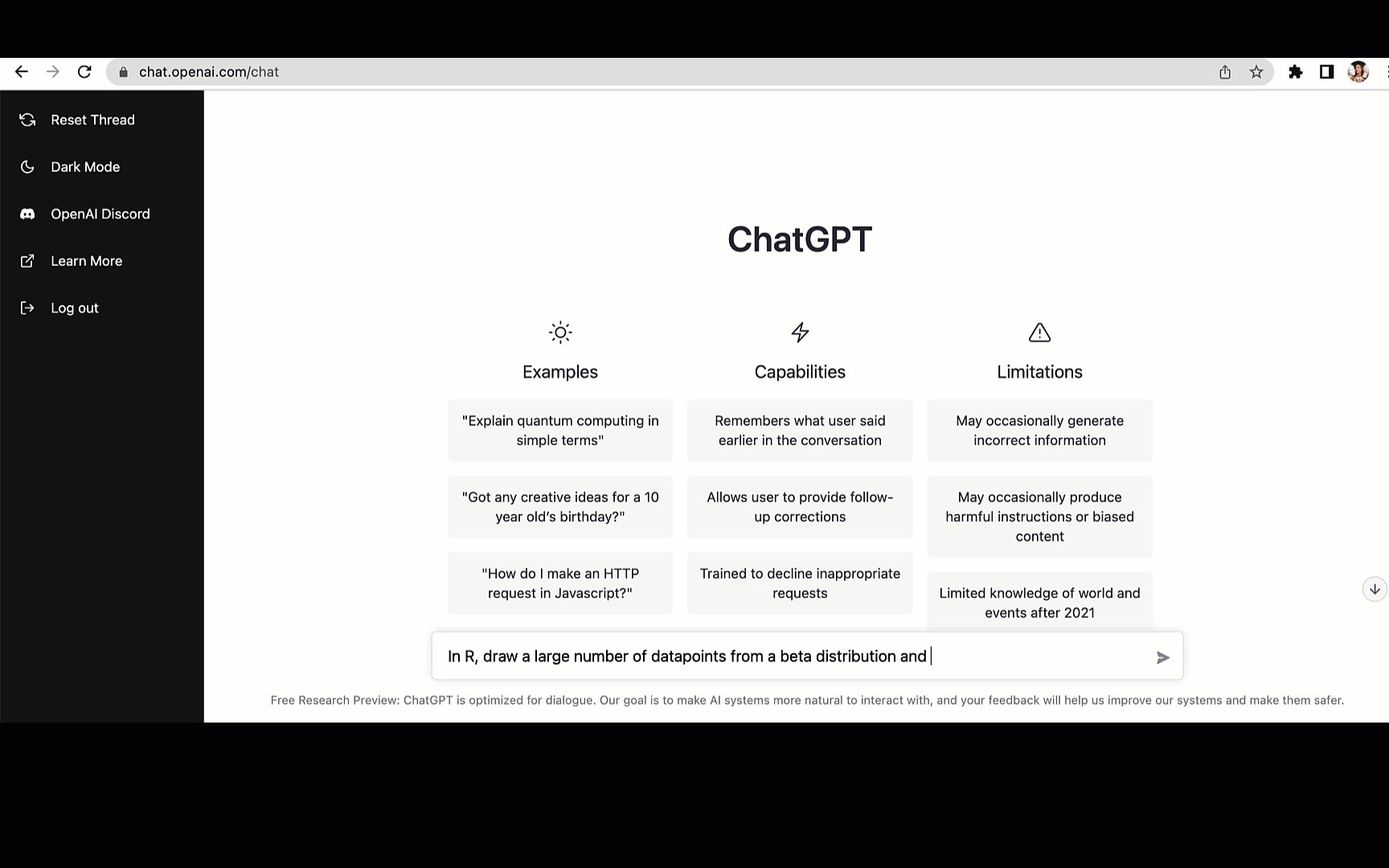Chapter 1: How to Learn ChatGPT (Basics)
1. What is ChatGPT
 ChatGPT is an artificial intelligence (AI) language model developed by OpenAI. It's built under an architecture called GPT (Generative Pre-Trained Transformers) to understand and generate human language.
ChatGPT is an artificial intelligence (AI) language model developed by OpenAI. It's built under an architecture called GPT (Generative Pre-Trained Transformers) to understand and generate human language.
Basically, ChatGPT can generate a human-understandable, coherent textual output based on a given input or "cue". This allows it to have a human-like conversation, which can be useful in many different applications, including but not limited to automated customer service, content creation, educational aids, and more.
ChatGPT and GANs explained

ChatGPT is an artificial intelligence tool that generates text for human conversations. GANs (Generative Adversarial Networks) are computer programs that can make images or other types of data look very real. ChatGPT uses something like GANs to allow it to generate natural conversations.
Both ChatGPT and GANs (generated confrontation network) are two important technologies in the field of artificial intelligence, but their principles and application scenarios are different.
-
ChatGPT : ChatGPT is an artificial intelligence language model developed by OpenAI. GPT stands for "Generate Pre-Training Transformer". In the pre-training phase, the GPT model learns to predict the next word from a large amount of text data. The ChatGPT model is further trained on top of this pre-trained model, enabling it to generate coherent and reasonable responses in a given context. It is commonly used for various tasks such as chatbots, text generation, automated email replies, etc.
-
GANs (Generating Against Networks) : GANs is a machine learning framework for generating models, proposed by Ian Goodfellow in 2014. GAN consists of two parts: one is the generator and the other is the discriminator. The goal of the generator is to generate data that is as close to real as possible (for example, if your goal is to generate images, the generator will try to generate images that look like real photos), while the goal of the discriminator is to distinguish which data is real , which data is generated by the generator. In this process, the generator and the discriminator compete against each other and improve continuously, and eventually the generator will be able to generate fake data that is very close to the real data. GANs have been widely used in the field of computer vision, especially in image generation, style transfer, super-resolution and other tasks.
In practical applications, ChatGPT and GANs can solve different problems and have important roles in many fields of AI.
How ChatGPT works
ChatGPT generates responses by learning a large amount of human language and then simulating the way humans talk. It should be noted that ChatGPT answers may not be real, they are created based on the patterns of human language. ChatGPT is a language model based on the GPT (generated pre-trained Transformer) model. How it works can be divided into two main stages: pre-training and fine-tuning.
1. Pre-training
During the pre-training phase, the model learns the ability to understand and generate text. It learns the patterns and structures of language by training on vast amounts of Internet text. The goal of a GPT model is to predict the next word in a given text sequence. For example, given "The sky is...", the model might predict "blue" as the next word.
The model in the pre-training stage is an autoregressive model, which means that it generates text word by word. First, it generates the first word, then it generates the second word based on all previous words, and so on.
2. Fine-tuning
The fine-tuning stage is based on the pre-trained model, using a smaller and more specific dataset for further training. In the case of ChatGPT, this dataset contains the conversations of human operators. In these conversations, an operator plays the role of ChatGPT, responding to another operator's questions and feedback. The purpose of this is to let the model learn how to generate appropriate responses in specific dialogue situations.
微调的过程也涉及到强化学习。OpenAI使用一种叫做"Proximal Policy Optimization"的方法,其中模型在尝试回应新的输入时,会参考多个可能的输出,并选择一个得分最高的进行回应。
ChatGPT的工作原理就是基于这样的预训练和微调过程。因为它在大量的文本数据上进行训练,所以它能够生成流畅、连贯、有意义的文本。同时,微调的过程使得它可以应对各种特定的对话场景。
ChatGPT 的优点
虽然ChatGPT 的回应可能并不真实,但它仍然可以提供非常有创意的对话。比如,你可以问 ChatGPT 一些假设性的问题,比如你给一个设定,ChatGPT它能飞,问它会做什么,它可以给你很多天马行空的想法。
ChatGPT 的使用场景· 因为 ChatGPT 能够进行有创意的思考,所以它可能对解决复杂问题和生成新想法有所帮助。只要我们明白它的回应可能并不真实,我们就可以用它来帮助我们探索超越现实的可能性。
ChatGPT 写代码

除了可以和人进行对话,ChatGPT 还可以写计算机代码。这是一种让计算机执行特定任务的语言。它写的代码片段有时候甚至可以真正运行。但需要注意的是,不是所有的代码都能正常工作,所以在使用 ChatGPT 生成的代码之前,需要检查一下是否正确。
对 ChatGPT 的一些误解
虽然文章之前提到 ChatGPT 使用了 GANs 的技术,但实际上,ChatGPT 并不是一个 GAN,而是一个叫做 "变压器" 的东西。变压器是一种不同的人工智能架构,和 GANs 是不同的。然而,尽管如此,ChatGPT 仍然可以生成有趣和有创意的对话。
2、ChatGPT简介:基础知识
ChatGPT是由OpenAI开发的大型人工智能语言模型,用于生成自然语言文本,尤其擅长参与对话,能够生成连贯、一致和详细的回复。它的设计目标是理解和生成人类语言,以此来进行各种类型的写作任务,从撰写电子邮件和文章,到答复用户问题,或者编写创意性的故事。
ChatGPT基础知识的要点:
-
模型架构:ChatGPT使用的是生成预训练变换器(GPT)架构。该架构基于Transformer模型,这是一种深度学习模型,它主要依赖自注意力(self-attention)机制来理解输入文本并生成预测。
-
预训练和微调:ChatGPT的训练过程分为两个阶段:预训练和微调。在预训练阶段,模型在大量的互联网文本上进行训练,学习语言的基本结构和模式。然后在微调阶段,模型在特定的任务数据集上进行额外的训练,这些数据集通常由人类在特定任务中生成的文本组成。
-
生成文本:当给ChatGPT提供一个文本提示时,它会生成一个或多个回复。这些回复取决于许多因素,包括输入的详细程度、明确性和上下文,以及模型在训练过程中学到的语言模式。
-
应用:ChatGPT可以用于各种应用,从提供客户服务,到编写创意内容,或者帮助学习语言。然而,尽管其性能很强大,但用户需要注意,ChatGPT并不完全理解它正在生成的文本,而是通过学习大量数据模拟人类语言。
-
GPT(Generative Pretrained Transformer):GPT 是 OpenAI 开发的一种大型语言模型。它的目标是生成接近人类的自然语言文本。GPT 采用了 Transformer 架构,该架构主要依赖于自注意力(self-attention)机制来生成预测。GPT 是一种预训练模型,这意味着在进行特定任务之前,它会被训练来理解和生成人类语言。GPT 的训练过程涉及到大量的互联网文本,训练目标是预测给定的一串词后面会出现什么词。通过这种方式,GPT 学会了词义、语法、以及一些常见的语言模式。
-
ChatGPT:ChatGPT 是在 GPT 基础上开发的一个聊天机器人。它使用了和 GPT 相同的预训练过程,但在此基础上进行了额外的微调,以优化其聊天和对话生成的能力。
3、怎样使用它
使用ChatGPT的方法如下:
-
访问ChatGPT:你可以通过OpenAI的官方网站或者使用API来访问ChatGPT。
-
**提供输入或"提示"**:一旦你开始与ChatGPT对话,你需要提供一个输入或"提示"。这可以是一个问题,一个主题,或者一个开启对话的语句。
-
阅读和响应输出:在你给出提示后,ChatGPT将会生成一个响应。这个响应将基于你的输入和ChatGPT在大量文本数据中学到的模式。
-
调整和优化:如果你发现ChatGPT的回应不符合你的需求,你可以尝试调整你的输入,使其更具体或明确,以引导ChatGPT产生更好的响应。
需要注意的是,虽然ChatGPT非常强大,但它并不完全理解它所产生的语言。它是根据它从大量文本中学到的模式,来生成可能的回应。因此,使用ChatGPT时需要谨慎,并且需要在使用的过程中持续进行监督和指导。
This article is published by mdnice multi-platform